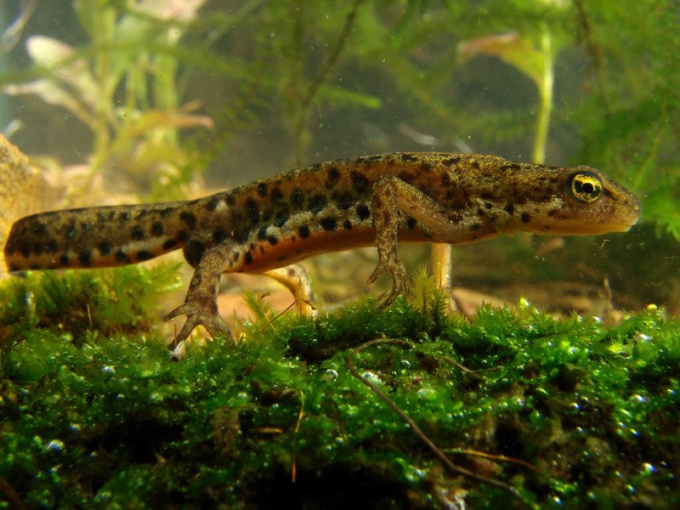Aquarium newts: General information
With proper care, these amphibians can live in captivity (in an aquarium) to 30 years. These animals are direct relatives of other amphibians – salamanders and are protected. That is why their content is extremely limited. Another thing – common subspecies of these newts (spined, comb, common, Alpine). Their content does not regulated, which allows to acquire such unusual Pets.
Aquarium newts: a description of the types
At home can contain about 10 species of newts, but the most common are three of them. The first is the ordinary Triton. It usually grows to a length of 9-12 cm Its olive-brown back and yellowish belly gives it a mysterious look. Also, these newts are dotted with a scattering of yellow spots. Lissotriton vulgaris has a on the head a longitudinal line. The male on the back (from head to tail) grows scallop.
The next type of aquarium newts – comb. This amphibian is much larger than its previous counterpart. It grows to a length of 18 cm Comb tritons are painted in black or brown. The abdomen they have orange, there are numerous spots. As the name implies, these creatures also have crests, but they have a bit shorter than the ordinary newt. Comb newts as a defense from enemies using poisonous substance secreted skin glands. Therefore, the content requires special care.
And finally, the third type of aquarium newts is ribbed newt. This creature is the largest of pet amphibians. In length it grows to 30 cm. the name of this Triton is received through the tips of the fins sticking out at the sides of his abdomen. At rest they are hidden, but it's worth spined Triton to worry about as they open, forming a needle. These amphibians are painted in dark green and has a pale yellow abdomen. Their entire body is dotted with black lesions.
The maintenance and care of aquarium newts
Not quite the correct view is that the contents of newts in captivity is troublesome and costly. In order to properly contain these amphibians at home, you need to have a basic set of knowledge. First, we should not forget that amphibians – a cold-blooded animals: their body temperature depends entirely on the environment. Therefore, the optimal aquarium temperature for them is 15 to 20oC. No additional heat sources (UV lamp, lamp filament) is not needed here.
Second, the newt is amphibious animals, meaning they can live both in water and on land. So do not forget about equipment aquarium artificial "island" (rocks, tents, rafts). Of course, there are a totally aquatic species of newts, but they are not popular among hobby aquarists.
Thirdly, aquarium newts can live both in groups and alone. For them it does not matter. Of course, the more newt is planned to have, the more capacity you need to purchase an aquarium. One of Triton should have no less than 12 liters of water.
As a primer you need to use sand or gravel. In the aquarium can accommodate both living and artificial plants. Newts usually do not touch them. Only during the breeding season they wrapped them in their eggs. Aquarium decorations should not be too expressive to amphibian not hurt about them.
It is important to know that aquatic newts eat only live food: earthworms, small fish, shrimp, larvae, flies, snails. Will not give these creatures from the small pieces of meat, kidneys or liver. Experienced aquarists suggest is to give the tritons once a month vitamins. Young animals need to be fed every day and adults every other day.
You must know that from time to time aquarium newts molt. Usually before that is why they RUB their head on the rocks. Once the skin breaks, they knock it off and then eat. These amphibians are quite slow creatures. They can spend hours in limbo, clinging to the walls of the aquarium or plants. Puberty newts reach to 3 years. In this time the animal lays eggs, carefully guarding her. The fry appear after a month.
